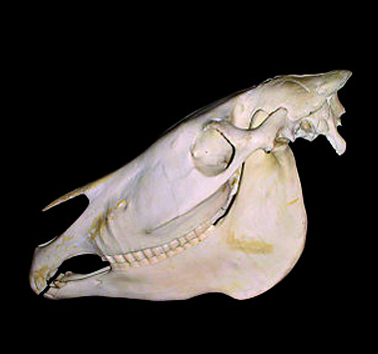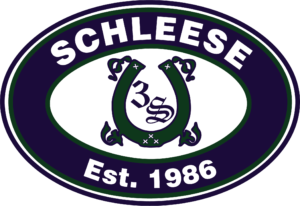Fitting a Bridle Properly – Part II
It’s all in your head… or your horse’s head!
Continuing on from last week with The Neck
Scientists have determined that there needs to be at least ½” room between the incisors where the bit is laid (so that a carrot could fit), to allow the horse to comfortably chew while bridled. There are two acupuncture points located in the headpiece area, which influence neck flexibility, back movement, and collection ability of the horse. If the flash or noseband is buckled too tightly, not only are these acupuncture points inhibited, but also the meridians which are located on either side of the head (the intestinal meridians). This further influences the flexibility of the haunches as well as proper breathing.
If there is too much pressure at the base of the skull from the headpiece, irritation results. Experiments have shown that during a canter while on the bit, the pressure is doubled here. Since the nerve here is also connected to the skin at the ears, the horse will show reluctance to have his ears touched when there is too much pressure from the bridle. This nerve also connects to the tongue musculature, possibly leading to further problems in the forelegs, since the muscles here are also connected to many of those muscles responsible for movement in the forelegs. (I know this sounds totally weird, but it is anatomically true).

The Zygomatic Arch
A noseband which is too tight not only puts extra pressure on the neck at the headpiece; it presses directly on a nerve and also influences an acupuncture point. This nerve comes directly out at the zygomatic arch which is right under the noseband.
The noseband of some types of bridles mirrors the exit point of the branches of two nerves (“Nervus trigeminus” and “Nervus facialis”) at the “foramen infraorbitale” which can be felt at the top of the upper jaw bone. The bridle needs to be correctly fitted and buckled in order not to rub against these bone projections. Although pressure on bone won’t necessarily cause any damage to the bone itself, it will cause pain. So called pressure necrosis will develop which can cause hair loss or the formation of white hairs – similar to when saddle pressure points cause issues.

The Lower Jaw
Many of the nerve insertion points are easily seen on the horse’s naked skull. One of the key ones can be seen exiting at the lower jaw at the “Foramen mentale”. It is close to the end of the horse’s mouth and extra care must be taken when the chain is attached so that it is not too tight.
Ear Salivary Gland
Pressure here will cause the horse to salivate, which leads to the chewing motion. If the bridle is too tight here and the horse feels resistance to being able to chew, enhanced saliva production will cause the horse stress and muscle tightening. The saliva will not be swallowed; it will simply drip out of the horse’s mouth. The hyoid lies beneath this gland, which is connected to a nerve in the ear. Too much pressure can furthermore impact the ability of the horse to maintain proper balance. There are more acupuncture points at the base of the ears where the browband sits. This acupuncture point ensures that both the jaw as well as the S-I joint remain mobile, and has influence on the meridians responsible for the bladder, gall bladder, and small intestine – all of which further influence movement of both the fore-and hindlegs.
In a study done at the University of Sydney the impact of too tightly buckled nosebands on chewing, eye temperature, and heart beat rate was examined on 12 horses using a Swedish double bridle. With a too tightly buckled noseband, stress indicators were indicated by increased heartbeat and higher eye temperatures.

The Nostrils
Nosebands and flashes may not be positioned too low on the horse’s face lest they ‘push’ closed the nostrils and impact the breathing ability of the horse, as well as causing heat build-up in the lungs. This is especially important to watch for in the Hanoverian style bridle, which can further impact two important acupuncture points if it is buckled too low and tight.
The Cheeks
The noseband and flash can also cause problems with the mucous membranes in the mouth. If these are too tight, the edges of the teeth in the upper jaw will press against these, as well as against the skin of the cheeks, and can cause injuries. This is particularly painful, if the teeth have not been filed for a while and have hooks or spurs. It is important to keep these loose (2 fingers room). Flash nosebands are usually only used when there is an issue with the horse keeps his mouth open too wide or likes to put his tongue over the bit.
The throatlatch should of course also not be too tight, and at best should have about 2-3 fingers of room to hang somewhat loosely. It should never be so tight as to be completely flush with the horse’s cheek.
The question arises whether additional padding makes a difference in the comfort for your horse – especially padding under the noseband and headpieces. It has been shown that pressure actually increases for the horse with additional padding – especially at the headpiece, where this would be akin to wearing a riding helmet that is too tight (think of the headaches this causes!). However, additional padding at the noseband has a more positive result, although nowadays many manufacturers build the extra soft padding right into their bridles from the get go.
In summary, it is always best to try out several bridles on your horse, to determine what works best for him. Every horse is different, and you may find that a combination of pieces and sizes is the best solution. The key is to try a bridle for a couple of rides, since anything new may cause different behaviour. The bit of course is another variable, but you as the rider will know best what your horse likes and can read how he reacts. Next blog I’ll go through some of the bridle types available with pros and cons.
©2017 Saddlefit 4 Life® (with thanks to St. Georg, June 2017 issue)
